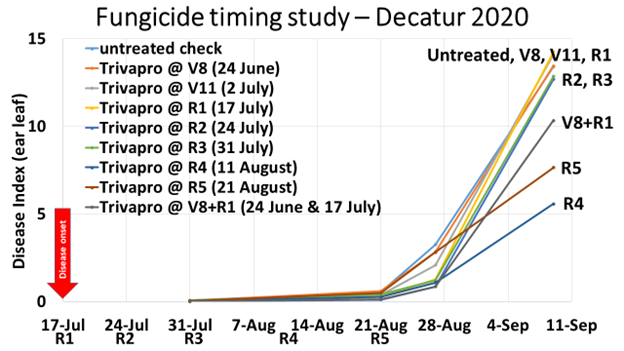By: Martin Chilvers, Associate Professor and Field Crops Pathologist, Department of Plant, Soil and Microbial Sciences
Should I be concerned with tar spot in 2021?
Possibly. If you or your neighbors have experienced tar spot in previous years, it is likely present in your fields this year. The frequent rainfall and near-constant leaf wetness from the end of June through early July provided ideal conditions to get tar spot started. Leaf wetness through the rest of the growing season will determine how much of an issue it is.
What does set this year apart from others is how widespread tar spot fungal inoculum is. Over the last couple of years, inoculum has been spreading across the state, and tar spot has also been found across the border in Ontario. We are actively tracking tar spot as shown in the map below, to date we have confirmed tar spot in 11 counties, and I expect it is present in many more.
Figure 1: Map of historical tar spot confirmations in light grey and 2021 tar spot confirmations in yellow as of July 19, 2021 (www.corn.ipmpipe.org).
How do I identify tar spot?
In terms of identifying a tar spot lesion, it is relatively distinct with a hard black raised spot (1/16 – 3/4 inch diameter) that will not rub off the leaf surface. Tar spot lesions form on the top side of the leaf but will often protrude through the bottom side of the leaf. Insect frass (bug poop) is often confused with tar spot, however, these are easy to distinguish as frass will dissolve and wipe off the leaf with some water, while tar spot will not. Late season rust pustules can also take on a dark color and look similar to tar spot, but upon close inspection, rust pustules erupt through the leaf leaving a torn margin, and rust spores will wipe off the leaf onto your finger. If in doubt send a sample into the MSU Plant and Pest Diagnostic Services https://pestid.msu.edu/. Or send a picture via email to chilvers@msu.edu or via Twitter @MartinChilvers1.
How should I manage tar spot?
Long-term tolerant hybrids will be one of our most important tools for tar spot management. Unfortunately, no hybrid is immune to tar spot, but there is variation in hybrid susceptibility. We are actively working with colleagues and industry to screen for resistance to tar spot.
In the short term, when disease is present and conditions are favorable a fungicide application can help to reduce disease and yield loss.
If I apply a fungicide which one should I use?
In general, we recommend the use of a fungicide product with mixed modes of action, this should give better control than a single mode of action. But, should also help slow development of fungicide resistance in the tar spot pathogen. The figure below shows the yield data from one of our tar spot trials conducted in 2020, with a fungicide application at R1 (July 17, 2020).
Figure 2: Yield data from 2020 tar spot trial conducted with a susceptible hybrid in an irrigated field. Fungicide treatments were applied on July 17, 2020.
We are currently conducting additional fungicide efficacy trials and will report those at the end of the year. Data from CMPM supported studies and input from neighboring states was used to develop a fungicide efficacy chart which can be found at: https://cropprotectionnetwork.org/resources/publications/fungicide-efficacy-for-control-of-corn-diseases
When should I apply a fungicide?
Depending on the timing of disease onset and weather, a fungicide application somewhere between VT/R1 through to R3 will likely be the best timing. Early vegetative applications tend to have little effect on suppressing tar spot epidemics.
In 2020, we conducted a fungicide timing trial in an irrigated field near Decatur, MI. Tar spot was first detected in this field on July 16 at very low levels, with rapid increase in disease severity during August and September. The figure below illustrates the amount of disease recorded on the ear leaf during the course of the season. Disease ratings on August 27 revealed that fungicide applications on July 24 (R2), July 31 (R3), August 11 (R4) and the double application on June 24 + July 17 (V8 + R1) resulted in lower levels of disease, while those applied earlier and later did not differ from the untreated check. By September 9, almost two weeks later, the amount of disease on the ear leaf had increased substantially. The only treatments significantly different from the untreated check were those applied on August 11 (R4) and 21 (R5), indicating that the residual fungicide from earlier timings was no longer effective. However, in this situation and probably most others, delaying the fungicide until R5 allowed disease to develop earlier in the season. Such a late application will often be too late for adequate disease suppression, and will likely not see a ROI. No significant differences were found in yield between the treatments in this trial, due to variability in the field.

Figure 3: Tar spot disease index (amount of tar spot on the ear leaf) of different fungicide timing treatments tracked over time
This work was supported in part by the Corn Marketing Program of Michigan (CMPM), Project GREEEN, and MSU AgBioResearch.
I discussed this issue in detail with Kristin Poley, research manager for CMPM in the video below.








